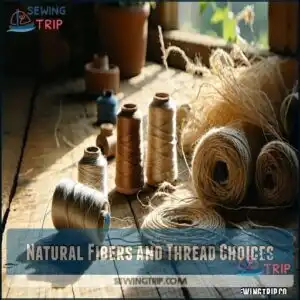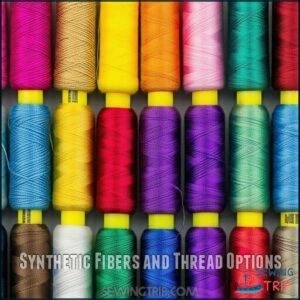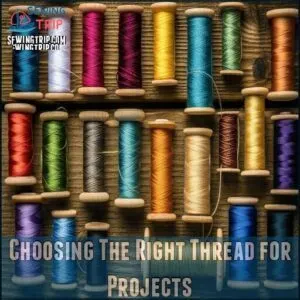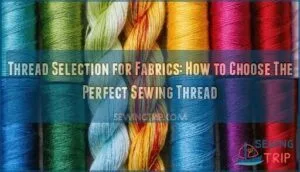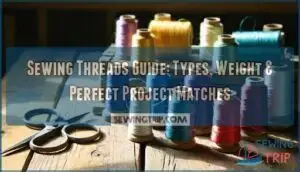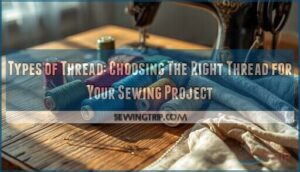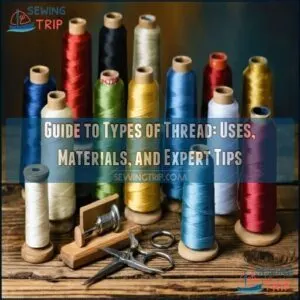This site is supported by our readers. We may earn a commission, at no cost to you, if you purchase through links.
 You’re about to start a sewing project and you’re wondering how to select sewing thread.
You’re about to start a sewing project and you’re wondering how to select sewing thread.
Choosing the right thread can be overwhelming, but it’s easier than you think.
You’ll want to examine the type of fabric, thread thickness, and color to guarantee a strong and durable seam.
By understanding the basics of thread selection, you’ll be able to choose the perfect thread for your project.
Now, let’s get started on the journey to mastering the art of thread selection, and discover the secrets to making your sewing projects truly unforgettable, with the right thread.
Table Of Contents
Key Takeaways
- You’ll choose the right thread by matching its fiber to your fabric type, considering thickness, and intended use, ensuring compatibility and best results for your sewing project.
- To guarantee strong seams and a professional finish, you’ll need to evaluate fabric type, weight, and project requirements to select the perfect thread size, typically ranging from 20 to 100, with lower numbers indicating thicker threads.
- You’ll want to consider factors like thread weight, strength, and color to pick the perfect thread that suits your needs, and don’t forget to check the thread’s durability, colorfastness, and suitability for your fabric type.
- By learning how to select sewing thread, you’ll be able to confidently pick the right one, ensuring strong seams, and a beautiful finish, and you can use all-purpose polyester thread as a versatile option suitable for most fabrics and projects.
Thread Selection Basics
You’re about to learn the fundamentals of selecting the right sewing thread for your projects.
By understanding thread selection basics, you’ll be able to choose the perfect thread to match your fabric type, considering factors like thread thickness, weight, and color.
Matching Thread to Fabric Type
When selecting thread, match fiber properties to fabric type, considering fabric weight and thread strength.
Match fiber properties to fabric type for strong seams
Choose thread material that complements your project requirements, ensuring a strong bond between needle size, thread, and fabric, for ideal thread selection and matching, aligning with the fabric type for the best results always.
For a variety of options, consider different thread types to find the best results and ensure ideal thread selection.
Considering Thread Thickness and Weight
When choosing thread, consider thread thickness and weight, as they impact seam appearance.
Thread numbering indicates weight, with lower numbers being thicker.
Match thread weight to fabric weight for best results, adjusting machine tension and needle size accordingly to guarantee proper stitching and prevent breakage or uneven seams.
Different projects require specific thread weight options for optimal outcomes, highlighting the importance of proper stitching.
Choosing Thread Color and Finish
You’re considering thread thickness, now think about color and finish.
- Color Matching
- Finish Types
- Thread Sheen
- Special Finishes to blend or contrast with your fabric, using the color wheel to guide your choice of thread color and finish.
Selecting Sewing Thread Type
You’ll need to examine several factors when selecting a sewing thread type, including the fabric you’re working with and the project’s intended use.
By choosing the right thread type, you can guarantee that your sewing projects turn out strong, durable, and professional-looking, so it’s worth taking the time to get it right.
Space Exploration Costs
You’ll explore space exploration costs, including Launch Vehicle Costs and Mission Operation Costs, to understand Research & Development and Infrastructure Investment.
Noting International Collaboration affects thread weight, strength, and durability, guiding your thread selection for superior quality, is crucial for Research & Development.
Alien Life Forms
You’re now pondering alien life forms, a fascinating topic.
Extraterrestrial biology sparks curiosity, with theories like Panspermia and the Fermi Paradox guiding SETI research on exoplanet habitability.
Much like selecting the right thread weight and color for sewing projects, these concepts guide our understanding of the universe, making exoplanet habitability a crucial area of study.
Galaxy Dark Matter
You’re diving into Galaxy Dark Matter.
- Dark Matter Density affects galaxy formation
- Dark Matter Halos surround galaxies
- Galaxy Rotation Curves are influenced
- Gravitational Lensing reveals dark matter, guiding your thread selection guide for superior thread quality and strength, like choosing the right sewing thread.
Scientists can use gravitational lensing effects to reveal dark matter.
Thread Fiber and Fabric Compatibility
You’ll need to examine the type of fabric you’re working with to choose the right thread fiber, as natural fibers like cotton and silk require different threads than synthetic fibers like polyester.
By matching your thread fiber to your fabric type, you can guarantee a strong and durable seam that will withstand wear and tear.
Natural Fibers and Thread Choices
You choose threads like cotton, silk, or linen to match natural fibers.
| Thread | Fiber | Use |
|---|---|---|
| Cotton | Natural | Clothing |
| Silk | Natural | Embroidery |
| Linen | Natural | Accessories |
| Wool | Natural | Knits |
| Rayon | Semi-synthetic | Decorative |
Synthetic Fibers and Thread Options
You’ll find synthetic fibers offer various benefits.
Consider these options:
- Polyester Durability
- Nylon Elasticity
- Acrylic Softness.
Polyester thread and nylon thread provide thread strength and durability, making them ideal for projects requiring synthetic fibers, like Blended Synthetics, with a nice Rayon Sheen.
Blending Thread Fibers for Optimal Results
You blend thread fibers to achieve ideal results, combining strengths like durability and softness.
This creates hybrid threads with unique properties, offering benefits like improved performance and creative combinations.
But also presents blending challenges in finding perfect blend ratios for sewing thread types and fabric compatibility.
Selecting the right thread involves understanding thread fiber content, which is crucial for achieving ideal results.
Thread Size and Machine Compatibility
You’ll need to take into account thread size and machine compatibility so that your sewing projects turn out well.
When choosing a thread, you should select a size that’s compatible with your sewing machine, as threads that are too thick can cause issues, while thinner threads may not provide enough strength.
You should consider these factors to ensure your projects are successful, and compatibility is key to achieving good results.
Understanding Thread Size and Weight Numbers
You’ll encounter thread size and weight numbers, like Tex or denier, indicating thickness.
Thread weight measurements, such as 30 wt or 50 wt, show thickness, with lower numbers being thicker.
Understanding thread size vs weight is key to selecting the right thread for your project, and knowing this difference is crucial for a successful project.
Choosing The Right Thread for Sewing Machines
When sewing, you’ll need thread for your sewing machine that suits its capabilities, considering machine tension, needle size, and thread brands to prevent lint buildup, ensuring smooth operation and ideal results with proper thread storage.
Selecting thread from well-known brands can also improve your sewing projects, ensuring consistent stitches with proper thread storage.
Serger Thread and Overlock Machine Compatibility
Serger and overlocker threads are thinner to prevent bulk and optimize high-speed stitching.
Use thread cone sizes for loopers due to high consumption. Adjust serger looper tension and differential feed settings to avoid thread breakage issues.
While serger thread suits overlockers, it’s not ideal for sewing machines. Many options for purchasing serger thread are available online.
Pick proper serger needle size for smooth sewing machine compatibility during projects, ensuring a high-speed stitching process.
Choosing The Right Thread for Projects
Selecting the right thread guarantees your sewing project holds up and looks polished.
You’ll need to evaluate the fabric type, weight, and purpose to match it with a thread that complements both durability and appearance.
Thread for Delicate and Heavy Fabrics
For delicate fabrics, use silk thread.
Heavy fabrics like denim require denim thread or upholstery thread.
Consider thread weight and tension settings for ideal results.
- Thread strength
- Thread weight
- Fabric type
- Thread matching
- Tension settings
Thread for Knits and Stretchy Fabrics
For knits and stretchy fabrics, you’ll need thread with elasticity, like polyester thread, to maintain seam elasticity.
This thread ensures needle compatibility and proper tension adjustments for a smooth finish, preventing breakage.
Thread for Decorative and Embellishment Purposes
For decorative purposes, you’ll love Metallic Threads, Glow-in-Dark, and Rayon Thread for embellishments, while Embroidery Thread and Invisible Thread work well for machine embroidery and decorative stitches, adding a touch of elegance to your projects with these specialty threads.
Proper thread selection depends on matching thread to fabric, which is a critical aspect of ensuring your projects turn out as expected, with the right thread selection being key to a professional finish.
Frequently Asked Questions (FAQs)
How do I choose the right thread for my sewing project?
You’ll choose the right thread by matching its fiber to your fabric type, considering thickness, and intended use, ensuring compatibility and best results for your sewing project.
How do you choose a sewing thread size?
You’ll need to evaluate fabric type, weight, and project requirements to select the perfect thread size, typically ranging from 20 to 100, with lower numbers indicating thicker threads, for ideal results.
How many types of sewing thread are there?
You’ll find numerous types, including cotton, polyester, silk, rayon, nylon, and more, each with unique characteristics and uses in sewing projects, offering various options for different fabrics and techniques.
What type of sewing thread should I choose?
Thread selection is like finding a key to reveal your sewing project’s potential.
Consider fabric type, weight, and intended use to pick the perfect thread that suits your needs perfectly always.
How do I choose the right thread for my fabric?
You’ll select the right thread by matching its fiber to your fabric type, considering factors like weight, stretch, and intended use to guarantee compatibility and superior results.
How do I know if my sewing thread is good?
You’ll know your sewing thread is good if it’s durable, colorfast, and suitable for your fabric type, with a smooth finish and minimal lint or fraying.
How do you determine sewing thread size?
You determine sewing thread size by checking the thread’s weight, usually indicated by a number, with lower numbers signifying thicker threads, and higher numbers indicating finer threads for sewing projects.
How do you find the right thread?
You’ll find the right thread by matching its fiber to your fabric type, considering thickness, and choosing a suitable color to guarantee compatibility and a professional finish for your project.
How do you pick out a thread?
You’ll choose a thread by considering fabric type, weight, and project needs, then matching thread fiber, thickness, and color to guarantee compatibility and superior results for your sewing project.
What is the best thread for everyday sewing?
You’ll want all-purpose polyester thread, a versatile option suitable for most fabrics and projects, offering strength, durability, and flexibility for everyday sewing needs.
Conclusion
You’ll be a thread-selecting master, choosing the perfect match for your fabric like a pro.
With millions of threads out there, learning how to select sewing thread is key.
Now, you can confidently pick the right one, ensuring strong seams, and a beautiful finish, making how to select sewing thread a breeze.





